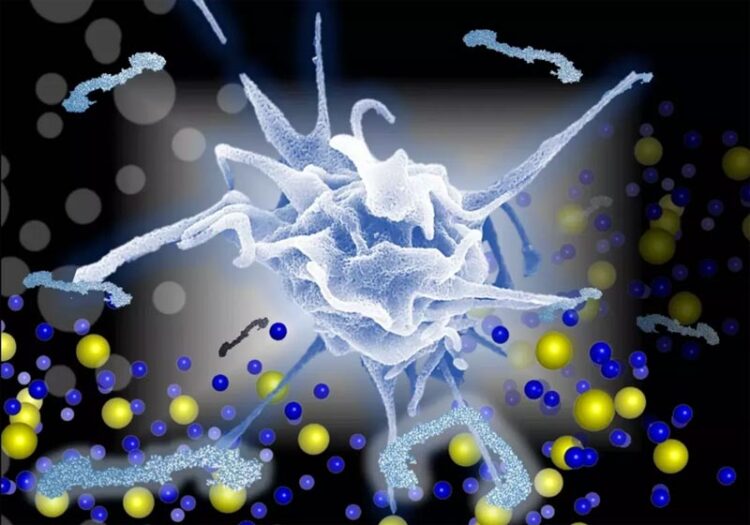Specially coated titanium reduces risk of clots on prostheses

The crystallographic orientation, and therefore surface atom arrangement, determine the material surface energy and wettability, controlling the cellular response to blood-contacting biomaterials. This image shows a crystallographic orientation-dependent fibrinogen conformation on the TiO2 surface (titanium and oxygen atoms marked as blue and yellow spheres) and its effect on platelet adhesion and activation. The different activation state is evidenced by platelet morphology (non-active: discoid and active: spread cells). The different behavior of platelets indicates the possibility of minimizing the risk of thrombosis on implants by adjusting the appropriate crystallographic orientation of the material surface. Picture: Maja Struczynska
An international research team led by the german University of Jena has now developed a promising approach to significantly reducing blood clotting on the heart valve material titanium.
Around 25,000 artificial heart valves are implanted in Germany per year because the original heart valve is damaged, for example, by an infection. The mechanical heart valves are made of titanium dioxide, among other materials, and last for many years. However, because blood tends to clot on contact with these material surfaces, there is a risk of blood clots forming on the surface of mechanical heart valves. This can become life-threatening if such blood clots break away from the materials. For this reason, most people with mechanical heart valves take medication throughout their lives to reduce blood clotting.
An international research team has now developed a promising approach to significantly reducing blood clotting on the heart valve material titanium. The results of the team from the Universities of Jena, Leipzig (both Germany) and Illinois Urbana-Champaign (USA), led by materials scientist Professor Klaus D. Jandt, have now been published in the journal Advanced Healthcare Materials. The journal also acknowledges the importance and potential of this discovery by featuring it on the cover of the current issue.
Platelet activity changes according to material coating
The researchers produced deposits of the blood protein fibrinogen on titanium dioxide with crystallographically differently oriented surfaces. The coated material surfaces then were exposed to blood platelets (thrombocytes), the activity of which, together with fibrinogen, plays a decisive role in the formation of blood clots. Significant differences in platelet activity were found on the material surfaces with different orientations.
“While the platelets are very active on (001) titanium oxide surfaces and thus promote blood clotting, we found the opposite effect on (110) surfaces,” says PhD student Maja Struczynska. “The reason for this is the different behaviour of fibrinogen on the material surfaces.”
“The mechanism for this effect is physical,” says Prof. Jandt, adding: “Fibrinogen adopts a specific fold on the more hydrophobic (110) surface with low surface energy, which in turn limits the access of the primary amino acid sequences recognised by platelets, thus minimising their adhesion.” Jandt sees enormous potential in the application of these materials to heart valves, as it should reduce the risk of blood clot formation and associated complications, and thus be of benefit to those affected.
Wissenschaftliche Ansprechpartner:
Prof. Klaus D. Jandt
Otto Schott Institute of Materials Research
Friedrich Schiller University Jena
Löbdergraben 32, 07743 Jena, Germany
Tel.: +49 (0)3641 / 947730
E-mail: k.jandt@uni-jena.de
Originalpublikation:
Maja Struczynska, Izabela Firkowska-Boden, Nathan Levandovsky, Reinhard Henschler, Nour Kassir, and Klaus D. Jandt: How Crystallographic Orientation-Induced Fibrinogen Conformation Affects Platelet Adhesion and Activation onTiO2, Advanced Healthcare Materials 2023, DOI: 10.1002/adhm.20220250
Media Contact
All latest news from the category: Materials Sciences
Materials management deals with the research, development, manufacturing and processing of raw and industrial materials. Key aspects here are biological and medical issues, which play an increasingly important role in this field.
innovations-report offers in-depth articles related to the development and application of materials and the structure and properties of new materials.
Newest articles

Sea slugs inspire highly stretchable biomedical sensor
USC Viterbi School of Engineering researcher Hangbo Zhao presents findings on highly stretchable and customizable microneedles for application in fields including neuroscience, tissue engineering, and wearable bioelectronics. The revolution in…

Twisting and binding matter waves with photons in a cavity
Precisely measuring the energy states of individual atoms has been a historical challenge for physicists due to atomic recoil. When an atom interacts with a photon, the atom “recoils” in…

Nanotubes, nanoparticles, and antibodies detect tiny amounts of fentanyl
New sensor is six orders of magnitude more sensitive than the next best thing. A research team at Pitt led by Alexander Star, a chemistry professor in the Kenneth P. Dietrich…





















